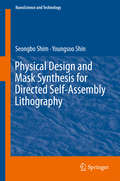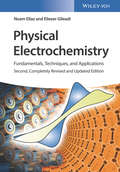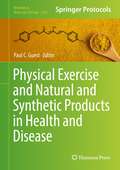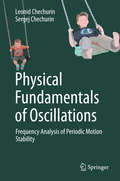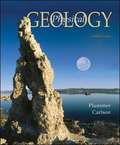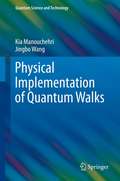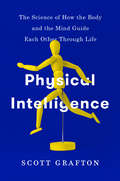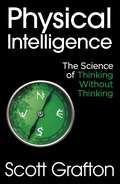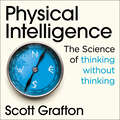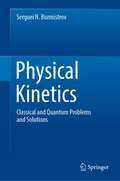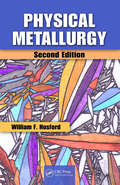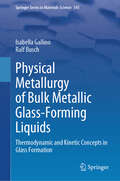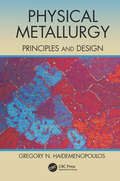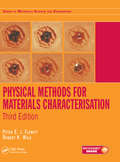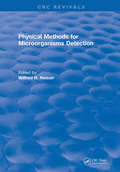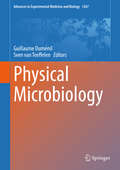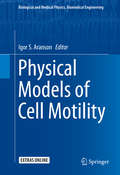- Table View
- List View
Physical Design and Mask Synthesis for Directed Self-Assembly Lithography (NanoScience and Technology)
by Youngsoo Shin Seongbo ShimThis book discusses physical design and mask synthesis of directed self-assembly lithography (DSAL). It covers the basic background of DSAL technology, physical design optimizations such as placement and redundant via insertion, and DSAL mask synthesis as well as its verification. Directed self-assembly lithography (DSAL) is a highly promising patterning solution in sub-7nm technology.
Physical Electrochemistry: Fundamentals, Techniques, and Applications
by Noam Eliaz Eliezer GileadiThis bestselling textbook on physical electrochemistry caters to the needs of advanced undergraduate and postgraduate students of chemistry, materials engineering, mechanical engineering, and chemical engineering. It is unique in covering both the more fundamental, physical aspects as well as the application-oriented practical aspects in a balanced manner. In addition it serves as a self-study text for scientists in industry and research institutions working in related fields. The book can be divided into three parts: (i) the fundamentals of electrochemistry; (ii) the most important electrochemical measurement techniques; and (iii) applications of electrochemistry in materials science and engineering, nanoscience and nanotechnology, and industry. The second edition has been thoroughly revised, extended and updated to reflect the state-of-the-art in the field, for example, electrochemical printing, batteries, fuels cells, supercapacitors, and hydrogen storage.
Physical Exercise and Natural and Synthetic Products in Health and Disease (Methods in Molecular Biology #2343)
by Paul C. GuestThis detailed book explores protocols with the aim of testing aerobic exercise, resistance training, special diets, additives and natural products, which have led to new insights into the physiological and molecular aspects of health and disease. Many of these approaches have contributed to significant improvements in disease areas such as cardiovascular disease, cognitive dysfunction, diabetes, frailty, gliobastoma, metabolic syndrome, obesity, oxidative stress, and various cancers. This collection also provides important information on disease mechanisms and novel drug targets as each protocol is presented in the context of specific chronic diseases or different therapeutic areas. Written for the highly successful Methods in Molecular Biology series, chapters include introductions to their respective topics, lists of the necessary materials, step-by-step, readily reproducible protocols, and tips on troubleshooting and avoiding known pitfalls. Authoritative and reflective of research from all around the globe, Physical Exercise and Natural and Synthetic Products in Health and Disease serves as an ideal guide for researchers in the areas of chronic disease, exercise, and nutrition, as well as to clinical scientists, physicians, and pharmacologists as it gives insights into possibilities for the development of novel therapeutics and the means of monitoring therapeutic response through the measurement of molecular and physiometric biomarkers.
Physical Foundations of Continuum Mechanics
by A. Ian MurdochIan Murdoch's Physical Foundations of Continuum Mechanics will interest engineers, mathematicians, and physicists who study the macroscopic behaviour of solids and fluids or engage in molecular dynamical simulations. In contrast to standard works on the subject, Murdoch's book examines physical assumptions implicit in continuum modelling from a molecular perspective. In so doing, physical interpretations of concepts and fields are clarified by emphasising both their microscopic origin and sensitivity to scales of length and time. Murdoch expertly applies this approach to theories of mixtures, generalised continua, fluid flow through porous media, and systems whose molecular content changes with time. Elements of statistical mechanics are included, for comparison, and two extensive appendices address relevant mathematical concepts and results. This unique and thorough work is an authoritative reference for both students and experts in the field.
Physical Foundations of Cosmology
by Viatcheslav MukhanovInflationary cosmology has been developed over the last twenty years to remedy serious shortcomings in the standard hot big bang model of the universe. Taking an original approach, this textbook explains the basis of modern cosmology and shows where the theoretical results come from. The book is divided into two parts; the first deals with the homogeneous and isotropic model of the Universe, the second part discusses how inhomogeneities can explain its structure. Established material such as the inflation and quantum cosmological perturbation are presented in great detail.
Physical Fundamentals of Oscillations: Frequency Analysis Of Periodic Motion Stability
by Leonid Chechurin Sergej ChechurinThe book introduces possibly the most compact, simple and physically understandable tool that can describe, explain, predict and design the widest set of phenomena in time-variant and nonlinear oscillations. The phenomena described include parametric resonances, combined resonances, instability of forced oscillations, synchronization, distributed parameter oscillation and flatter, parametric oscillation control, robustness of oscillations and many others. Although the realm of nonlinear oscillations is enormous, the book relies on the concept of minimum knowledge for maximum understanding. This unique tool is the method of stationarization, or one frequency approximation of parametric resonance problem analysis in linear time-variant dynamic systems. The book shows how this can explain periodic motion stability in stationary nonlinear dynamic systems, and reveals the link between the harmonic stationarization coefficients and describing functions. As such, the book speaks the language of control: transfer functions, frequency response, Nyquist plot, stability margins, etc. An understanding of the physics of stability loss is the basis for the design of new oscillation control methods for, several of which are presented in the book. These and all the other findings are illustrated by numerical examples, which can be easily reproduced by readers equipped with a basic simulation package like MATLAB with Simulink. The book offers a simple tool for all those travelling through the world of oscillations, helping them discover its hidden beauty. Researchers can use the method to uncover unknown aspects, and as a reference to compare it with other, for example, abstract mathematical means. Further, it provides engineers with a minimalistic but powerful instrument based on physically measurable variables to analyze and design oscillatory systems.
Physical Gels from Biological and Synthetic Polymers
by Madeleine Djabourov Katsuyoshi Nishinari Simon B. Ross-Murphy Madeleine Djabourov Katsuyoshi NishinariPresenting a unique perspective on state-of-the-art physical gels, this interdisciplinary guide provides a complete, critical analysis of the field and highlights recent developments. It shows the interconnections between the key aspects of gels, from molecules and structure through to rheological and functional properties, with each chapter focusing on a different class of gel. There is also a final chapter covering innovative systems and applications, providing the information needed to understand current and future practical applications of gels in the pharmaceutical, agricultural, cosmetic, chemical and food industries. Many research teams are involved in the field of gels, including theoreticians, experimentalists and chemical engineers, but this interdisciplinary book collates and rationalises the many different points of view to provide a clear understanding of these complex systems for researchers and graduate students.
Physical Geology (12th Edition)
by Charles C. Plummer Diane H. CarlsonOne excellent reason to read this book is that it's tried and true. Since the book was published in 1979, over 1,000,000 students have read this text as an introduction to physical geology. Proportionately, geology instructors have relied on this text for over 5,000 courses to explain, illustrate, and exemplify basic geologic concepts to both majors and non-majors. Today, the 12th edition continues to provide contemporary perspectives that reflect current research, recent natural disasters, unmatched illustrations, and unparalleled learning aids. We have worked closely with contributors, reviewers, and our editors to publish the most accurate and current text possible.
Physical Geology: Earth Revealed, Ninth Edition
by Charles C. Plummer Diane H. Carlson Lisa HammersleyThe ninth edition has been updated to include the most current information from the various sub-disciplines that comprise physical geology. The book's purpose is to clearly present geologic processes so that students can understand the logic of scientific methods. This text features an outstanding art program and a proven, accessible writing style.
Physical Hydrology, Third Edition
by S. Lawrence DingmanThe text is organized around three principal themes: the basic concepts underlying the science of hydrology; the exchange of water and energy between the atmosphere and the earth's surface; and the land phase of the hydrologic cycle.
Physical Implementation of Quantum Walks
by Kia Manouchehri Jingbo WangGiven the extensive application of random walks in virtually every science related discipline, we may be at the threshold of yet another problem solving paradigm with the advent of quantum walks. Over the past decade, quantum walks have been explored for their non-intuitive dynamics, which may hold the key to radically new quantum algorithms. This growing interest has been paralleled by a flurry of research into how one can implement quantum walks in laboratories. This book presents numerous proposals as well as actual experiments for such a physical realization, underpinned by a wide range of quantum, classical and hybrid technologies.
Physical Intelligence: The Science of How the Body and the Mind Guide Each Other Through Life
by Scott GraftonElegantly written and deeply grounded in personal experience—works by Oliver Sacks come to mind—Physical Intelligence gives us a clear, illuminating examination of the intricate, mutually responsive relationship between the mind and the body as they engage (or don&’t engage) in all manner of physical action.Ever wonder why you don&’t walk into walls or off cliffs? How you decide if you can drive through a snowstorm? How high you are willing to climb up a ladder to change a lightbulb? Through the prisms of behavioral neurology and cognitive neuroscience, Scott Grafton brilliantly accounts for the design and workings of the action-oriented brain in synchronicity with the body in the natural world, and he shows how physical intelligence is inherent in all of us—and always in problem-solving mode. Drawing on insights gleaned from discoveries by engineers who have learned to emulate the sophisticated solutions Mother Nature has created for managing complex behavior, Grafton also demonstrates the relevance of physical intelligence with examples that each of us might face—whether the situation is mundane, exceptional, extreme, or compromised.
Physical Intelligence: The Science of Thinking Without Thinking
by Scott Grafton'An instant classic' Michael S. Gazzaniga, author of The Consciousness InstinctHow do you pick the right moment to cross a busy road?Or decide if you can drive through a storm? What helps you discover a shortcut to a familiar route?The answer is PHYSICAL INTELLIGENCE.Renowned neuroscientist, doctor and keen climber Scott Grafton draws on the very latest research, experiences with patients and his own dangerous hikes in the wilderness to explore the hidden depths of this silent intellect we all possess.Physical Intelligence explains the science behind our oldest ability and takes a fascinating and vital look at how we could and should use it better.
Physical Intelligence: The Science of Thinking Without Thinking
by Scott GraftonWhat is it that stops us from walking into walls or off cliffs? How do you pick the right moment to cross a busy road Or decide if you can drive through a storm? What helps you discover a shortcut to a familiar route?The answer is PHYSICAL INTELLIGENCESometimes, you need to do it to know it. Your hands have to be on the steering wheel to learn the feel of slipping tyres. You need to be watching the traffic to judge the best moment to cross the road. Everything we do, from changing a lightbulb to navigating unknown terrain relies on physical intelligence, our oldest and most important form of cognition. Physical intelligence was the key development in human evolution; thinking evolved first and foremost so we could do things. It has been the key to our survival against all the odds for so long that it has become instinctive, and continues to underpin our every action, from the ordinary (walking down a street) to the extraordinary (winning a race) and beyond. Renowned neuroscientist, doctor and keen climber, Scott Grafton was fascinated to discover how physical intelligence's most important components were laid bare, away from civilisation. In this book he takes you on a journey to explore the hidden depths of this silent, ruthless intellect we all possess. Drawing on the latest scientific discoveries and research, experiences with patients, and Professor Grafton's own gripping stories of survival in the wilderness, Physical Intelligence explains the science behind our most overlooked ability and takes a fascinating and vital look at how we could and should use it better. (P)2020 Hodder & Stoughton Limited
Physical Kinetics: Classical and Quantum Problems and Solutions
by Serguei N. BurmistrovThis book includes problems based on the material in the course of physical kinetics for the students of general and applied physics. It contains 60 problems with detailed solutions. The comments to the problems reflect the connection with the problems and methods of modern physical kinetics. A brief introduction gives the necessary information for solving and understanding the problems. The book is proposed for students and postgraduates studying the theoretical physics. The book is used as a supplement to the textbooks published on physical kinetics. The purpose of the book is to help students in training the practical skills and mastering the basic elements of physical kinetics. To understand the subject matter, it is sufficient to know the traditional courses of theoretical physics.
Physical Metallurgy
by William F. HosfordFor students ready to advance in their study of metals, Physical Metallurgy, Second Edition uses engaging historical and contemporary examples that relate to the applications of concepts in each chapter.This book combines theoretical concepts, real alloy systems, processing procedures, and examples of real-world applications. The author uses his ex
Physical Metallurgy of Bulk Metallic Glass-Forming Liquids: Thermodynamic and Kinetic Concepts in Glass Formation (Springer Series in Materials Science #341)
by Isabella Gallino Ralf BuschThis book deepens the current understanding of the thermodynamics and kinetics of metallic glass-forming liquids, and their connection with the glass-formation process in terms of fundamental physical metallurgy concepts. It surveys and reports on the progress made in the last few decades to access the ultra-viscous liquid state of thermally stable bulk metallic glass (BMG) forming alloys and study the changes in atomic structure, viscosity, and enthalpy during the vitrification including physical aging.Featuring a comprehensive look at the physical properties of the undercooled liquid in the ultra-viscous state at temperatures near the glass transition, the book reports on detailed investigations of the thermodynamic functions, viscosity, volume, relaxation time, and structural ordering in the undercooled liquid. Additionally, it introduces state-of-the-art in-situ characterization tools such as chip-calorimetry, synchrotron x-ray diffraction, and x-ray photon correlation spectroscopy as applied to novel studies of liquid–liquid transitions in the supercooled liquid and in the vicinity of the glass transition, and establishes these common, if not universal, phenomena in BMG-forming alloys.This book is intended for researchers, graduate students, and professionals in the fields of materials science, physical metallurgy, and condensed matter physics, who are interested in the thermodynamics and kinetics of metallic glass-forming liquids and their connection with the glass formation process.
Physical Metallurgy: Principles and Design
by Gregory N. HaidemenopoulosPhysical metallurgy is one of the main fields of metallurgical science dealing with the development of the microstructure of metals in order to achieve desirable properties required in technological applications. Physical Metallurgy: Principles and Design focuses on the processing–structure–properties triangle as it applies to metals and alloys. It introduces the fundamental principles of physical metallurgy and the design methodologies for alloys and processing. The first part of the book discusses the structure and change of structure through phase transformations. The latter part of the books deals with plastic deformation, strengthening mechanisms, and mechanical properties as they relate to structure. The book also includes a chapter on physical metallurgy of steels and concludes by discussing the computational tools, involving computational thermodynamics and kinetics, to perform alloy and process design.
Physical Methods for Materials Characterisation (Series in Materials Science and Engineering)
by Peter E. Flewitt Robert K. WildThis completely revised and expanded new edition covers the full range of techniques now available for the investigation of materials structure and accurate quantitative determination of microstructural features within materials. It continues to provide the best introductory resource for understanding the interrelationship between microstructure and physical, mechanical, and chemical properties, as well as selection and application of techniques for both basic and applied studies. In particular, changes have been made to reflect developments in analysis of nanoscale and biological materials.
Physical Methods for Microorganisms Detection
by W. H. NelsonThis volume presents detection and identification methods for bacteria and yeast. Chapters are written by expert laboratory practitioners and instrument makers and focuses on those methods that show widespread practical application, such as ATP luminescence. Food applications include rapid detection and quantitation of bacteria in raw milk, pasteurized milk, other dairy products, and raw meat. Other topics include brewing applications for beverages, starter culture monitoring, clinical analyses, blood and urine analysis procedures, analysis of aerosols, bioprocess safety, and biodeterioration. This book is a must for microbiologists in food quality labs and clinical labs.
Physical Microbiology (Advances in Experimental Medicine and Biology #1267)
by Guillaume Duménil Sven Van TeeffelenThis book emerges from the idea that specific physics-inspired approaches are necessary to understand different stage of bacterial physiology and the infections they cause. Many aspects of bacterial life depend on processes typically described by physical laws: The rheology of biofilms is determined by complex cohesive forces. Physical laws of diffusion are essential to all processes of bacterial metabolism. The formation of the numerous bacterial biomacromolecules require complex self-organization processes and their function are powered by potent molecular motors. Host-pathogen interactions during infection frequently occur in environments determined by fluid mechanics. In this book, different chapters represent research at the interface between microbiology and physics. Topics range from intracellular organization to cell-cell interactions. A good part of the book is devoted to mechanical forces, which are involved in the function of elaborate bacterial nanomachines, chromosome segregation, and cell division. The effect of bacterial toxins provides an example of the alteration of cellular membrane properties by bacteria. Symmetrically, histones from mammalian cells alter bacterial membranes as a defense mechanism during infection.The editors of this book, Guillaume Duménil and Sven van Teeffelen, have selected researchers at the forefront of research in physical microbiology to provide the most recent view in this fast-moving field. The contents of this book are designed to be accessible for scientists with training in biology and for scientists with training in physics. The objective is to provide a fresh perspective on microbiology and infection by highlighting recent multidisciplinary research and favor rapid advances at this fruitful interface.
Physical Modeling and Computational Techniques for Thermal and Fluid-dynamics: Practical Numerical Mathematics (Mechanical Engineering Series)
by Maurizio BottoniThis book on computational techniques for thermal and fluid-dynamic problems arose from seminars given by the author at the Institute of Nuclear Energy Technology of Tsinghua University in Beijing, China. The book is composed of eight chapters-- some of which are characterized by a scholastic approach, others are devoted to numerical solution of ordinary differential equations of first order, and of partial differential equations of first and second order, respectively. In Chapter IV, basic concepts of consistency, stability and convergence of discretization algorithms are covered in some detail. Other parts of the book follow a less conventional approach, mainly informed by the author’s experience in teaching and development of computer programs. Among these is Chapter III, where the residual method of Orthogonal Collocations is presented in several variants, ranging from the classical Galerkin method to Point and Domain Collocations, applied to numerical solution of partial differential equations of first order. In most cases solutions of fluid dynamic problems are led through the discretization process, to the numerical solutions of large linear systems. Intended to impart a basic understanding of numerical techniques that would enable readers to deal with problems of Computational Fluid Dynamics at research level, the book is ideal as a reference for graduate students, researchers, and practitioners.
Physical Models of Cell Motility
by Igor S. AransonThis book surveys the most recent advances in physics-inspired cell movement models. This synergetic, cross-disciplinary effort to increase the fidelity of computational algorithms will lead to a better understanding of the complex biomechanics of cell movement, and stimulate progress in research on related active matter systems, from suspensions of bacteria and synthetic swimmers to cell tissues and cytoskeleton. Cell motility and collective motion are among the most important themes in biology and statistical physics of out-of-equilibrium systems, and crucial for morphogenesis, wound healing, and immune response in eukaryotic organisms. It is also relevant for the development of effective treatment strategies for diseases such as cancer, and for the design of bioactive surfaces for cell sorting and manipulation. Substrate-based cell motility is, however, a very complex process as regulatory pathways and physical force generation mechanisms are intertwined. To understand the interplay between adhesion, force generation and motility, an abundance of computational models have been proposed in recent years, from finite element to immerse interface methods and phase field approaches. This book is primarily written for physicists, mathematical biologists and biomedical engineers working in this rapidly expanding field, and ca n serve as supplementary reading for advanced graduate courses in biophysics and mathematical biology. The e-book incorporates experimental and computer animations illustrating various aspects of cell movement.
Physical Models of Semiconductor Quantum Devices
by Ying FuThe science and technology relating to nanostructures continues to receive significant attention for its applications to various fields including microelectronics, nanophotonics, and biotechnology. This book describes the basic quantum mechanical principles underlining this fast developing field. From the fundamental principles of quantum mechanics to nanomaterial properties, from device physics to research and development of new systems, this title is aimed at undergraduates, graduates, postgraduates, and researchers.
Physical Modifications of Starch
by Zhongquan Sui Xiangli KongThis book provides comprehensive information on starch modification using physical approaches – a field that has attracted increasing interest in recent years due to the fact that it is no longer desirable to label starch a modified. The required functionalities can be conveniently achieved by physical methods that are less expensive and more environmentally friendly. Intended for researchers and product developers working on starch, the book summarizes recent developments in the areas of starch physical modifications and reviews the structure, function and potential industrial applications of modified starch. Dr. Zhongquan Sui is an Associate Professor at Shanghai Jiao Tong University. Dr. Xiangli Kong is an Assistant Professor at Zhejiang University.
